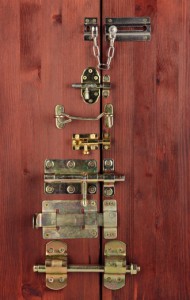Understanding ANSI Lock Grades
ANSI grades rank locks based on security and performance

What Are ANSI Grades?
All quality locks are awarded an ANSI grade of 1, 2, or 3, based on their performance on various tests administered by the American National Standards Institute. Grade 1 locks are rated to provide the highest level of residential security, Grade 2 locks provide intermediate security, and Grade 3 locks provide basic security.
Lock Types
Because locks are tested within different lock type categories, not all Grade 1 locks provide the same amount of security. For example, the three main lock types tested are cylindrical knob locks, auxiliary deadbolts, and mortise locks. Mortise locks are inherently more durable than knob locks simply because of the way they are designed, so a Grade 3 mortise lock will actually last as many open and close cycles as a Grade 1 knob lock.
ANSI Lock Testing Criteria
As part of the lock testing process, ANSI researchers install various locks in test doors and then subject them to rigorous abuse. Some of the main criteria used in testing locks to determine ANSI grades include:
Cycles: The cycle test checks the locks for durability and ease of operation over the lifetime of the lock. One cycle consists of turning the knob of lever handle to completely retract the latch, and then allowing it to relatch or manually relatching it. Grade 1 locks will last through many more cycles than lower grade locks. For example, a Grade 3 knob lock only has to last 200,000 cycles, but a Grade 1 knob lock has to last 800,000 cycles.
Latch Bolt Projection: Another testing criterion involves how far the latch bolt projects outside of the lock case. The longer the latch bolt, the more of it will project beyond the strike plate and the harder it will be to break open.
Deadbolt Projection: The test for deadbolt projection is similar to the latch bolt test. The difference is that whereas a Grade 1 latch bolt only has to be ½ inch long on a knob lock and ¾ inch long on a mortise lock, all deadbolts have to be 1 inch long.
Strike Impact Resistance: Another very important test is the strike impact test or hammer test. Basically this test checks how well the lock can resist a thief’s attempt to bash or kick the lock open. Grade 1 locks can offer over twice as much protection as Grade 3 locks in many cases. For example, a Grade 3 deadbolt only has to withstand 3 hammer strikes, but a Grade 1 deadbolt will withstand 10.
Additional tests may be used on certain lock types to test features unique to those lock types.
Need Help Selecting and Installing Your Locks?
If you would like help selecting the best locks for your home or business, please contact RBM Lock & Key. We can show you a wide selection of locks appropriate for your needs and provide the professional lock installation you need to get the best possible performance from your locks.

 909-980-3448
909-980-3448









 2235 E. 4th St Suite B, Ontario, CA 91764
2235 E. 4th St Suite B, Ontario, CA 91764